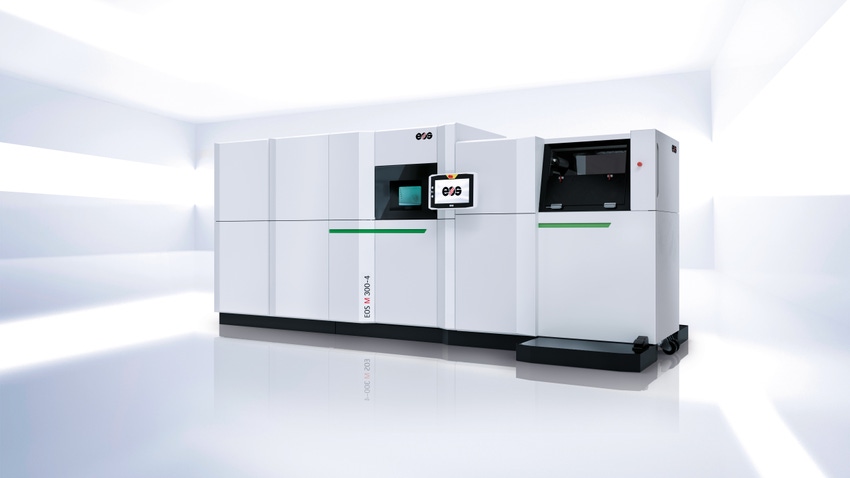EOS Introduces the M 300-4, a 'Future-Proofed' Metal Industrial AM System
EOS believes its latest metal additive manufacturing system is the first from a future where AM machines will need to be robust enough to operate 24/7.
October 22, 2018

|
EOS' M 300-4 industrial AM printer is the first of a new series. (Image source: EOS) |
Industrial additive manufacturing (AM) has one overriding goal today: to increase productivity while significantly reducing cost per part, which sounds like a tall order. In addition, new AM solutions must be able to integrate into current production while being ready—the word “future-proofed” is sometimes used—for up-and-coming applications. The AM systems of the future will need to be robust enough to operate 24/7. This is simply not possible with many of today’s machines, which require regular maintenance, cleaning, and filter changes between print jobs.
Germany’s EOS, which makes systems for industrial AM in both metal and polymers, recently debuted what it says is a “future-proofed” system at the 2018 IMTS show in Chicago. The M 300-4, the first of a new series, is a multi-laser metal 3D printing system designed and built for heavy-duty industrial additive manufacturing. It uses Direct Metal Laser Sintering (DMLS) technology built on an automation-ready, configurable, and scalable platform. DMLS is a process that uses a high power-density laser to melt and fuse metallic powders together, and the M 300-4 brings four lasers together. According to EOS, the machine is particularly proficient at dealing with the robust demands of industrial equipment—primarily in aerospace, automotive, medical, and tooling applications.
That Holy Grail of increased productivity and reduction of cost per part is achieved with the addition of a new scanning strategy with full-field overlap, the four separate laser sources, and laser spot sizes. The lasers operate in a 300 x 300-mm square with each laser covering the entire build area. A new exposure lets users choose the number of lasers required for the print job, their power, as well as a fixed or variable focus. Users can choose, for example, from 4 x 400- to a mixed set-up of 2 x 400- and 2 x 1,000- and all the way up to 4 x 1,000-watt laser power.
Sebastian Becker, product manager for metal systems at EOS, told Design News the system increases productivity by a factor of four to 10 compared to the EOS mid-frame system, the EOS M 290—significantly reducing cost per part.
“Cost per part is also influenced by machine setup, with customers able to select different options, such as variable or fixed focus and manual or automated part handling,” Becker said. “The machine also features a permanent filter system that eliminates the need to stop the machine and change the filter, allowing it to run up to 24/7. In effect, the machine can complete jobs without interruption, allowing for additional scalability and making parts cheaper in the process.”
The M 300-4 also provides choices in powder dosing options, depending on users’ needs. Users can choose between two dosing options for full build jobs without refilling. Bottom-up (or flexible dispenser) enables quick changes of materials. It is ideal for research and development applications when different materials are tested or parts are being prototyped. The second option, top-down dosing, is suited for closed-loop production to enable automated material dosing and sieving in line with health and safety standards for industrial environments.
One final element of customization is the ability to choose three different clamping systems (3R, Delphin, or Erowa). In this model of AM system, there are more opportunities for automation—particularly for part unpacking, powder sieving, and preparing for the next build job. EOS is bringing more robotics online to automate more downstream post-processing and (ultimately) lower the cost per build.
“Following build completion, a robot removes the build plate with the parts on it from the setup station and transports it under protective gas to a furnace for subsequent heat treatment,” Becker told Design News. “The same robot then removes the build plate from the furnace and transports it to a three-dimensional optical measurement system for quality assurance purposes. Finally, the build plate is conveyed to a saw, which separates the parts from the plate.”
The M 300-4 system is compatible with EOS’s Shared Modules concept—a way to automate and integrate production for better efficiency in logistics. Essentially, the entire setup, unpacking, transportation, and sieving phases of the manufacturing workflow can be carried out independently of, and parallel to, the actual printing process. EOS provides users with open interfaces to connect AM to existing manufacturing processes that are essential in mixed production environments that consist of both additive and conventional technologies.
The EOS M 300 series comes with software solutions for all additive manufacturing process steps—from the preparation of computer-aided design data and build job preparation to quality control. As such, it will be offered with the company's existing EOSPRINT 2, EOSTATE, and upcoming EOSCONNECT software platforms for build preparation, production, and monitoring (respectively.) At this time, the M 300-4 accommodates Inconel 718 and MS1 for materials, though the company says that aluminum and titanium will be the next materials to come for the series, and that new developments planned for the product line will bring opportunities for new applications.
Tracey Schelmetic graduated from Fairfield University in Fairfield, Conn. and began her long career as a technology and science writer and editor at Appleton & Lange, the now-defunct medical publishing arm of Simon & Schuster. Later, as the editorial director of telecom trade journal Customer Interaction Solutions (today Customer magazine), she became a well-recognized voice in the contact center industry. Today, she is a freelance writer specializing in manufacturing and technology, telecommunications, and enterprise software.
|
About the Author(s)
You May Also Like





